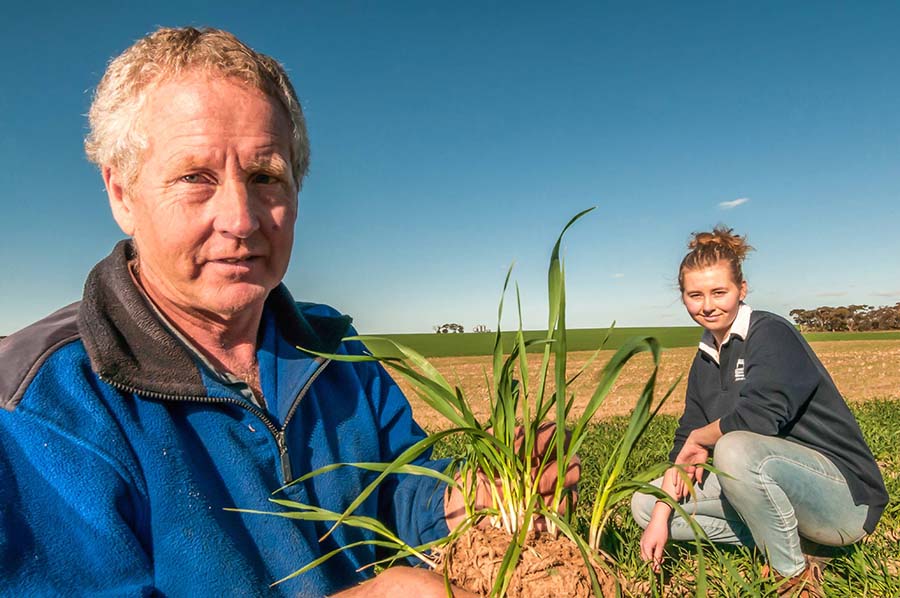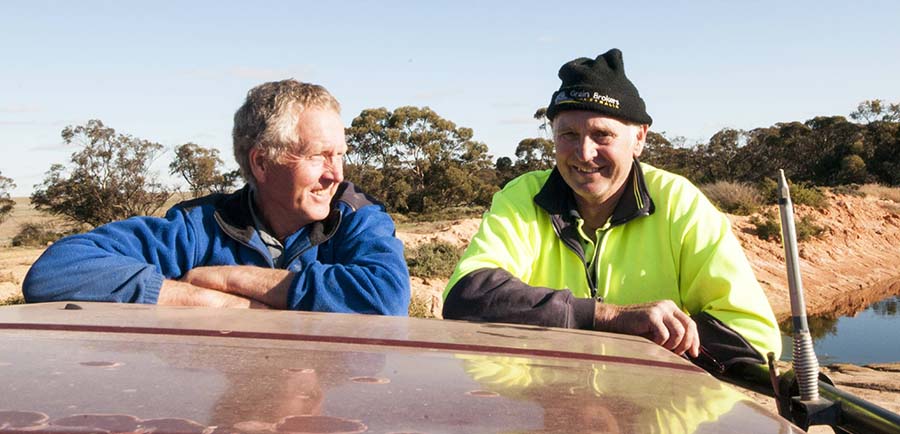Snapshot
- Owners: Kevin and Geoff Bond
- Farm area: 2960 hectares
- Average annual rainfall: 275 millimetres
- Location: Mannum, South Australia
- Soil types: non-wetting sands, sandy loam over clay and limestone
- Soil pH range: 6.9 to 8.5
- Crops grown: wheat, barley, canola, chickpeas, oaten hay, triticale, millet, sorghum, lucerne
Twin-sown summer grain crops - millet and sorghum - are unconventional cropping options in the Mallee region.
But these drought and heat-tolerant cereals can be found growing side-by-side on a swathe of the Bond family's property, about 12 kilometres east of Mannum in South Australia's Murray Mallee region.
For the Bond brothers, Kevin and Geoff, and co-workers Daryl Sparks and Brett Newman, companion planting millet and sorghum is a strategic farm management practice used to remediate parts of their 2960ha-property affected by 'Mallee seeps' land degradation.
The Bonds say this complex pattern of degradation, manifesting as large, bare patches of unproductive cropping country, has surfaced on 12 paddock areas, totalling about 25ha since 2000.

Kevin and Kate Bond examine wheat growth on the perimeter of a Mallee seep-affected area, which is toxic to plant roots. Photo: Clarisa Collis
This seep-affected farm area is relatively small, but its impact on logistics for paddock operations, such as seeding, spraying and harvesting, is significant.
In an effort to manage the problem, almost five years ago, the Bond farming team planted an experimental mix of millet and sorghum on and around the largest of their seep-affected areas, which vary in size from 0.05 to 5ha.
Their theory being that the hardy summer crops would help soak up excess water, provide protective ground cover and improve soil structure on seep areas prone to waterlogging before they become scalded.
They also aimed to minimise soil water capillary rise and high evaporation in summer that leads to salt concentration on the soil surface.
This ingenious strategy, initiated by the Bonds, was examined in trials established on the family's property in 2015 as part of Mallee seeps-focused research funded by Natural Resources SA Murray-Darling Basin (SAMDB).
The trial findings from 2015 to 2018 highlighting the effectiveness of growing summer crops on seep-affected areas has seen the approach recommended as one of four main management strategies that can help other Mallee growers tackle the issue.
Trials on the family's property looking at the effect of growing deep-rooted lucerne to help manage seeps have also prompted the Bonds to consider increasing their farm area planted to the pasture legume.
To date, trials on their farm have shown that planting large 35 metre-strips of lucerne on sand hills and ridges above seep sites can help intercept the lateral movement of water from the perched water table into affected areas.
However, the Bond farming team say attempts to establish the deep-rooted perennial on a larger-scale 20ha-area have been thwarted by dry seasonal conditions in the past few years.
Where seep degradation is more advanced, and has developed into highly saline scalds that are toxic to plant roots, including millet, sorghum and lucerne, Kevin, Geoff, Daryl and Brett say they are considering implementing a range of soil amelioration approaches.
In particular, they plan to ameliorate degraded areas by incorporating soil amendments, such as sand containing composted chicken manure and hay straw.
Measuring the effects of these amendments are new trials, set up in July, on one of the Bonds' developing seeps - the soil surface of which is not yet highly saline, but still too saline to support wheat and summer crop growth.
The on-farm trials were instigated by Insight Extension for Agriculture consultant Chris McDonough, with co-investment from the National Landcare Program's Smart Farming Initiative, GRDC and the South Australian Murray Darling Basin Natural Resource Management Board.
These trials are examining the rehabilitation impacts of incorporating (unaffected) sand on seep areas to a soil depth of 10 to 15 centimetres, as well as incorporation of sand containing chicken manure applied at 20 tonnes per hectare and hay straw applied at 30t/ha.

Kevin, left, and Geoff Bond initiated twin-sowing summer crops - millet and sorghum - to help remediate Mallee seeps on their family farm. Photo Clarisa Collis
"The trials on the Bonds' farm aim to assess whether degraded land can be brought back into crop production through placing soil on top of seep areas, and through planting and maintaining vegetation cover," Mr McDonough says.
"Using this approach, we may be able to assess at what point scalded land becomes too degraded to rehabilitate."
Gauging the efficacy of these soil amelioration options is regular soil testing and measurements of rainfall moisture recharge, crop water use, ground water fluctuations and soil water capillary rise using soil moisture probes and piezometers installed at trial sites on the family farm.
Kevin, Geoff, Daryl and Brett hope the trial findings, particularly those looking at soil acidification, might help remedy the problem of high pH soils in connection with seeps.
For example, researchers recorded a toxic soil pH of 11 in a seep area of the Bond farm where soil pH typically ranges from 6.9 to 8.5.
Other management strategies being considered by the Bond team are growing deep-rooted sunflowers and using a submersible bore to pump excess water - before it becomes saline - into a tank for on-farm use, such as spraying operations.
More information: Chris McDonough, 0408 085 393, cmcd.insight@gmail.com; Kevin Bond, 0435 081 240, krlabond@internode.on.net

























































